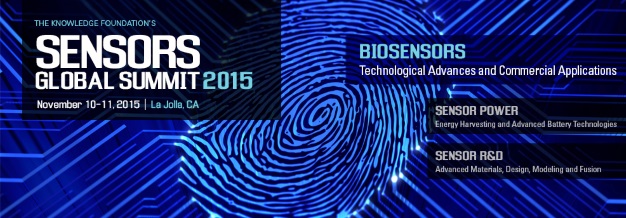
The Knowledge Foundation is pleased to present its Sensors Global Summit , which will take place November 10-11, 2015 at the Marriott San Diego La Jolla in La Jolla, CA. The event’s international faculty of key industry and academic leaders will cover the latest technological advancements of real-world applications within three conference tracks on Biosensors, Sensor Power, and Sensor R&D.
“By 2020, the exponential growth of the sensors market and the demand for next generation integrated systems is expected to reach $85 billion,” said Craig Wohlers, General Manager of The Knowledge Foundation. “With applications in areas such as healthcare, the environment, industry, security, and defense, biosensors alone will account for $25 billion of this market growth.”
Sensors Global Summit features four plenary keynote presentations, which will bring together attendees from all three conference tracks. Tuesday morning’s plenary session will include presentations from Dr. Ahmed Busnaina, Distinguished University Professor and Director of Northeastern University's NSF Nanoscale Science and Engineering Center for High-Rate Nanomanufacturing, and Peter Mason, Director of Cisco's Applications Platform Group. Dr. Busnaina will cover a new high-rate nanoscale printing process for sensors, energy, and materials applications, while Mr. Mason will discuss mobile experience application platforms for the Internet of Things and Internet of Everything.
Wednesday morning’s plenary keynote session will give attendees the opportunity to learn about personalization in sensor-rich environments, in vitro and in vivo nano-enabled diagnostic sensing platforms, and the successful translation and future applications of these platforms in personalized medicine and cancer. Presentations will be given by Martha G. Russell, Stanford University’s mediaX Executive Director, and Dr. Christopher M. Hartshorn, Program Manager of the National Cancer Institute’s Office of Cancer Nanotechnology Research.
In addition to the four plenary keynote presentations, Sensors Global Summit will offer more than twenty additional presentations on biosensor commercialization, energy harvesting and battery technologies for sensor applications, and the latest research in design and application of integrated sensors systems.
Final agenda for Sensors Global Summit
Emerging technological innovations enabled by next generation sensors will define the landscape for the future commercialization of life changing products. The exponential growth of the sensors market and the demand for next generation integrated systems is expected to reach $85 billion by 2020. Our international faculty of key industry and academic leaders will present the latest technological advancements of real-world applications within three sensor application tracks: Biosensors , Sensor Power , and Sensor R&D .
TRACK 1: BIOSENSORS
Technological Advances and Commercial Applications in Biosensing
The global market for biosensors is expected to reach over $25 billion by 2020. With biosensor applications in such areas as healthcare, environmental, industrial, security and defense, this market is expected to achieve exponential growth over the coming years.
TRACK 2: SENSOR POWER
Energy Harvesting and Advanced Battery Technologies for Integrated Sensor Applications
Power demands for next-generation sensors in a variety of applications provide significant challenges to scientists and engineers. A blended approach to power generation through advanced battery technology and energy harvesting is critical for the development of integrated sensors systems.
TRACK 3: SENSOR R&D
Advanced Materials, Design, Modeling & Fusion for Sensor Applications
Significant improvements in materials and engineering have paved the way for novel, multifunctional integrated sensor systems with unlimited market potential. Advancements in low-cost materials processing and printing techniques have enabled the development of cost-efficient sensor platforms for applications within such industries as life sciences, transportation, oil & gas, defense and consumer electronics.
For full conference details, visit http://www.sensorsglobalsummit.com.
Advertisement








